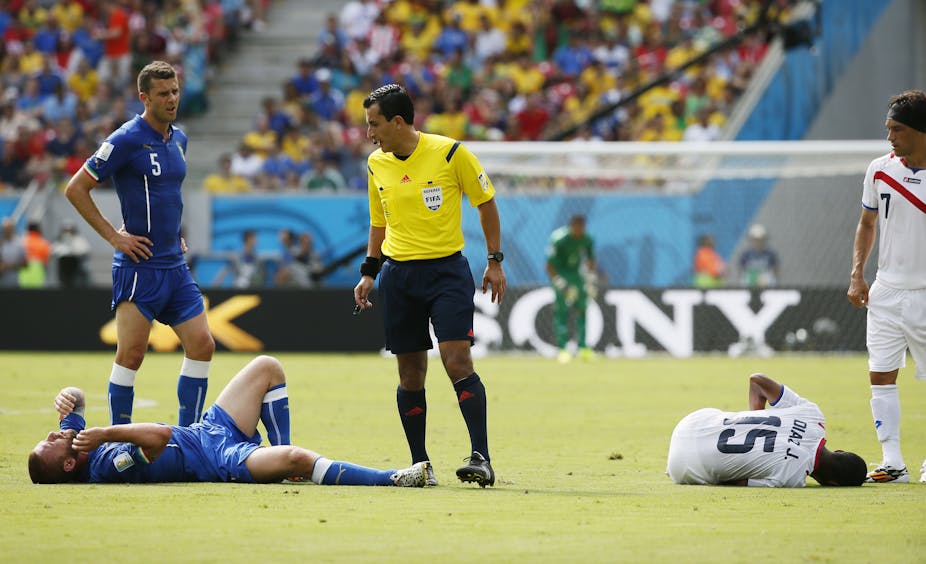We all know that professional football players feign injury. Is it getting worse? Probably. Do we know why? Not really, but history suggests some plausible answers.
The first thing to say is that feigning injury in football today has reached truly epidemic proportions. A Wall Street Journal article reported 132 minutes of “writhing time” in just 32 World Cup games. Of the 302 separate instances of players appearing to be very seriously hurt, 293 of them were up and playing within seconds. Just nine were actually injured.
Some defend footballers’ theatrics by pointing to the speed of the modern game. This is sycophantic nonsense. As players have become more technically skilled over the decades, the game has slowed to a comparative walk.
European professional football of the 1930s and 1940s, for example, was played at a breathless, breakneck pace. By comparison to the chess-like build-ups we see today, the game was a frantic and chaotic romp, with players constantly colliding into each other without complaint or recrimination.
The first three pre-World War II World Cups, won by Uruguay and Italy (twice) were by all accounts brutal affairs. Players played on with serious injuries and referees afforded them precious little protection.
The biographies of players from past eras, both English-speaking and not, also suggest that concealing pain and injury was not only seen as more manly, but a tactical necessity. Players never wanted their opponents to suspect they were hurt or, worse, easily intimidated.
Things began to change when ruling bodies decided to improve the image of football by cracking down on acts of thuggery. It is difficult to point to an exact starting point but anxiety about serious injury to players seems to have risen in professional football in the 1970s and intensified in the 1980s.
The result of this was that the threshold for what was considered a “foul” – or illegal body contact – plummeted. By the beginning of the 2000s, it was almost impossible for players in the top leagues to engage in what would once have been considered a legitimate “50-50” scrap for the ball.
Of course, possession of the ball does change regularly, but this is usually caused by an errant pass or a mis-controlled ball. Full-blooded, legal disputes over the ball between two players have largely disappeared from the game.
And this is the heart of the matter. Because it is now more than ever a possession game, being robbed of the ball by an opponent is one of the worst mistakes a player can make. And because it is more rare, it is all the more embarrassing when it happens.
In this situation, the histrionic behaviour players begins to look more rational. By screaming and hurling themselves onto the ground, players force referees to make a decision where one would previously not have been needed. And because of the low tolerance for rough play, the behaviour is usually rewarded with a free kick, no matter how slight the body contact.
Occasionally, though, referees decide not to award a free kick, at which point the “injured” player has a decision to make. Sometimes the recovery from death’s door is miraculously instantaneous because the player senses that his team actually needs him in the ensuing play.
Annoyingly often, though, the player decides that to discontinue the charade would amount to a confession of guilt, and so the performance goes on. Again, because of the safety-conscious mindset that prevails, this normally means that the game is stopped while the “injured” player is treated and often stretchered off the field before roaring back on to rejoin the fray.
The spread of this practice is bad for many reasons, not least of which is the extra unnecessary pressure it places on referees to make impossible on the spot judgements about whether a player is really hurt or not. It has also radically increased the incentives – and success rate – for players to time-waste and feign serious injury in order to have an opponent sent off.
As a result, send-offs in which the offending player has scarcely touched his opponent are now depressingly commonplace.
Most of all, feigning injury is an attempt to nullify the advantage an opponent gains from winning a contest for the ball. And so by reducing the tolerance for foul play, the game’s lawmakers have created a weirdly puritanical and hypocritical on-field culture in which exposing the misdeeds of others matters much more than one’s own ethical conduct.
What the melodrama of football players tells us is that banning one kind of behaviour almost always creates another. For every legalistic gain, there is a loss. In the case of football, an important loss has been the ability of referees to punish diving or “simulation”. Because feigning injury is now so rampant, football’s laws against it are surely the most regularly broken and yet under-enforced in all of sport.
As I see it, the only solutions are the use of video to retrospectively punish players who feign injury and the acceptance of the unfashionable ideas that not only can conflict and contestation be healthy, but that sometimes in life people are hurt and it is nobody’s fault.

